#Mantellisaurus
Text
Spinosaurus paleo art

Sorry if this one isn't as my previous art about utahraptors, I've been in a rush with this one. I'll be taking part in a small art exibition next week, and my deadline for this project is due to tommorow, so yeah, here's the story, enjoy!
#Dinosaur#Dinosaurs#spinosaurus#spinosauridae#Chicks#Babies#Hadrosaurs#Mantellisaurus#Herd#Herbivores#Carnivores#Plains#Woods#Forest#Water#Pond#Nature#Paleontology#Paleo art#Art#Digital art#Paleoart#Paint tool sai#Ilustration#spinosaurus aegyptiacus#Cretaceus period#Prehistory
16 notes
·
View notes
Text

A dinosaur shed tooth of an indeterminate ornithopod, likely an iguanodont from the Cliff End Bone Bed, Ashdown Formation in the Pett Level of Sussex, England. Iguanodontians are likely the most common ornithischians in this deposit.
#dinosaur#fossils#paleontology#palaeontology#paleo#palaeo#iguanodon#mantellisaurus#ornithopod#iguanodontidae#ornithischian#cretaceous#mesozoic#prehistoric#science#paleoblr#マンテリサウルス#イグアノドン#イグアノドン類#恐竜#化石#古生物学
1 note
·
View note
Text

0 notes
Text

artwork by @quetzalpali
361 notes
·
View notes
Text
Schrader Formation - Jurassic Worlds Prologue Speculative Ecosystem

The Schrader Formation is a fictional formation inspired by the Jurassic World Prologue sequence, set across Southern USA and Mexico. The speculative formation attempts to gather together what the Prologue presented to create a comprehensive speculative ecosystem, grounded within some reality.
Paleogeography-climatology
The Schrader Formation rests alongside the Pacific coastal regions of North America, extending far inland to mountainous, highlandic regions. A major river system and very narrow bays define the interior of the Schrader Formation, both leading directly to the sea. These wetter regions lead to more lush and occasionally, swampy lands.
The overall climate of the region is characterized by dry-wet season changes, resulting in dry weather and more humid weather throughout the year. Dry weather in open landscapes yields a very savanna-like appearance.
Biotic Interchange
The South U.S and Mexico region were major hotspots for a real-world biotic interchange during the Maastrichtian, allowing for groups, such as Titanosaurs, to cross into North America, and some groups, potentially ceratopsians and thyreophorans, crossing into South America. These instances of interchanges happened across the Cretaceous on rare occasions, but coincidentally, one happened in the Maastrichtian as well, leading to the south being populated with a mixture of two different ecologies.
Represented Species
The represented species in the chart correlates to some species shown within the Prologue. Species such as Tyrannosaurus rex, Alamosaurus, Glyptodontopelta, Ankylosaurus, Ojoraptorsaurus, Quetzalcoatlus, and both pteranodontids were directly present themselves in the southern U.S and Mexico. The Nasutoceratopsinid, Iguanodontid, Giganotosaurus, Dawndraco-like pterosaur, Moros, and the Mongolian-inspired Oviraptorid were sourced from other locations.
Nasutoceratopsid
The depicted Nasutoceratopsid is a large Nasutoceratops-derived species. The size and exaggerated combat features arose from the presence of Tyrannosaurus, pushing for defensive features as it did for Triceratops. While Nasutoceratops itself did not live to the end-Cretaceous, many relatives have, and speculatively, so did this species.
Nasutoceratopsids would make up a large portion of the biota mass, their high population and frequency would make them a particularly numerous species.
Smaller species of Nasutoceratopsids exist to represent their ancestors more closely, though they exist in much less large predator-dominated environments, namely in mountains or on islands. Their predators in return can include species like "Moros".
Oviraptorids
Two prominent genera of oviraptorosaurs exist across the Schrader Formation, Ojoraptorsaurus and an indeterminate oviraptorosaur. Oviraptorosaur indet. The identification of what oviraptorid group it belongs to is uncertain, although it being of late-surviving Mongolian descent is a possibility, given the eggs found in the region.
Iguanodontid
Iguanodontids are seen across Laurasia, species such as Iguanocollosus, Tenotosaurus, Hippodraco, etc are seen in North America. Here, a convergently Mantellisaurus-like species of Iguanodont derived from earlier ancestors present more up North and in Europe. Itself achieves a generally larger size than its ancestorial species, namely in defense against the larger predators due to them being more solitary.
Smaller-sized populations too like the Nasutoceratopsids exist in less Tyrannosaur-dominated regions of the formation, though they are not taxonomically distinct.
Ornithocheirid
While Ornithocheirae was thought to died out in the middle-late Cretaceous, a very slight possibility of them persisting to the Maastrichtian was always theorized. The known material found within the Schrader Formation indicate a very sparse population comprised of late-surviving, derived Ornithocheirids, being the last of the toothed pterosaurs.
While being traditionally associated with Gondwanian (South America, Australia, occasionally Europe, Africa) regions, their widespread distribution as a family allowed species to exist within North America. This specific species was able to take refuge and ecologically diverse from the rest of the Maastrichtian pterosaurs. Being found in more mountainous and both inland and coastal cliffsides. Although, some material indicates major overlap with the other pterosaur species of the ecology.
Isotopic analyses indicates a heavier diet of brackish and alkaline water fishes, often much larger fish species, as opposed to the carrion/small vertabrae-heavy diet of Quetzalcoatlus and saltwater and freshwatever heavy fish diet of both Pteranodontids.
Giganotosaurus
The nonspecific Giganotosaurus is derived from a population of Northward-increasing Giganotosaurids from South America. These species would eventually reach North America across the land bridge. Its diet of namely sauropods and hadrosaurs though would yield less competition than Tyrannosaurus. While Tyrannosaurus can take down large sauropods, it would instead target much smaller individuals due to its diet consisting of mainly armored animals.
Giganotosaurus though, would be better adapted to take down these larger sauropods, allowing for some niche differentiation from the start. Territorial disputes would exist regardless between both species, though they were not due to overlapping diets and ecological competition.
Authors note - A Giganotosaurus-lineage species of Carcharodontosaurid is the least likely thing to exist in this speculative evolution, but other lines of Carcharodontosaurids surviving (such as Labocania being a Carcharodontosaur) would've been more likely. For fun, lets run with Giganotosaurus.
------------------------------------------------------------------------------
Unrepresented Species
Many species were considered (and will eventually come) for the chart in the effort to help represent more southern North America species and some South American species and to flesh out the ecosystem.
Ojoceratops, Coahuilaceratops, Troodontids, Lambeosaurines, Orninthomimids, primitive Deinocheirids, Thescelosaurids, Unenlagians, Microraptorid (when Moros was intended to be a Microraptor), Tropeognathid, and many more were considered to be drawn. Eventually, they will be represented and this blog will be updated.
Standins / Representation
Glyptodontopelta is a standin for the unknown carcass the Quetzalcoatlus was feeding off. While absolutely nothing points it to the idea of being anything specific, Glyptodontopelta was chosen for nearby locality, added diversity, and obscure-species representation.
The Dawndraco-inspired smaller Pteranodontid is representative of the idea that two differently sized Pteranodon species were shown in the prologue, that being the large flock amongst the Quetzalcoatlus and the riverside. While it is either dubious CGI scaling, skewed perception of size, and camera angles, it was chosen regardless for added pterosaur diversity.
While Tlatolophus was considered regardless of the cut concepts, the Dominion prologue originally had Parasaurolophus possibly involved in art. We never see this obviously, although with the nearby Tlatolophus being near geologically, it would be fair to represent it quicker.
Microraptoridae indet. and Ornithocheirae indet. are both based off concepts for the short, where Microraptor was meant to replace Moros, and Ornithocheirus meant to replace Quetzalcoatlus.
Hope you enjoy this read! I will certainly expand upon it further.
-Jennifer
#prehistoric#paleoart#dinosaur#jurassic park#paleontology#theropod#jurassic world#art#speculative ecology#speculative evolution#jp30#jurassic park 30th anniversary#jurassic world dominion
24 notes
·
View notes
Text




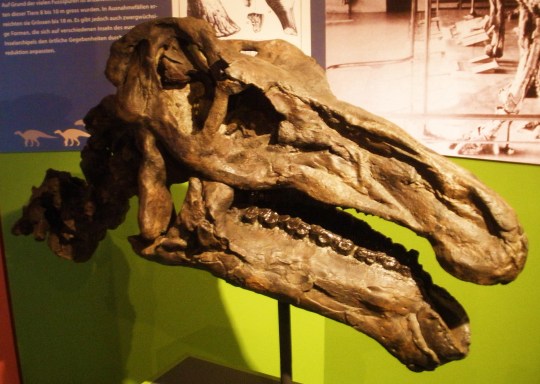

Iguanodon
(temporal range: 126-122 mio. years ago)
[text from the Wikipedia article, see also link above]
Iguanodon (/ɪˈɡwɑːnədɒn/ i-GWAH-nə-don; meaning 'iguana-tooth'), named in 1825, is a genus of iguanodontian dinosaur. While many species found worldwide have been classified in the genus Iguanodon, dating from the Late Jurassic to Early Cretaceous, taxonomic revision in the early 21st century has defined Iguanodon to be based on one well-substantiated species: I. bernissartensis, which lived during the Barremian to early Aptian ages of the Early Cretaceous in Belgium, Germany, England, and Spain, between about 126 and 122 million years ago. Iguanodon was a large, bulky herbivore, measuring up to 9–11 metres (30–36 ft) in length and 4.5 metric tons (5.0 short tons) in body mass. Distinctive features include large thumb spikes, which were possibly used for defense against predators, combined with long prehensile fifth fingers able to forage for food.
The genus was named in 1825 by English geologist Gideon Mantell but discovered by William Harding Bensted, based on fossil specimens found in England and was given the species name I. anglicus. Iguanodon was the second type of dinosaur formally named based on fossil specimens, after Megalosaurus. Together with Megalosaurus and Hylaeosaurus, it was one of the three genera originally used to define Dinosauria. The genus Iguanodon belongs to the larger group Iguanodontia, along with the duck-billed hadrosaurs. The taxonomy of this genus continues to be a topic of study as new species are named or long-standing ones reassigned to other genera. In 1878 new, far more complete remains of Iguanodon were discovered in Belgium and studied by Louis Dollo. These were given the new species I. bernissartensis. In the early 21st century it became understood that the remains referred to as Iguanodon in England belonged to four different species (including I. bernissartensis) that were not closely related to each other, which were subsequently split off into Mantellisaurus, Barilium and Hypselospinus. It was also found that the originally described type species of Iguanodon, I. anglicus was a nomen dubium, and not valid. Thus the name "Iguanodon" became fixed around the well known species based primarily on the Belgian specimens. In 2015, a second valid species, I. galvensis, was named, based on fossils found in the Iberian Peninsula.
Scientific understanding of Iguanodon has evolved over time as new information has been obtained from fossils. The numerous specimens of this genus, including nearly complete skeletons from two well-known bone beds, have allowed researchers to make informed hypotheses regarding many aspects of the living animal, including feeding, movement, and social behaviour. As one of the first scientifically well-known dinosaurs, Iguanodon has occupied a small but notable place in the public's perception of dinosaurs, its artistic representation changing significantly in response to new interpretations of its remains.
5 notes
·
View notes
Text
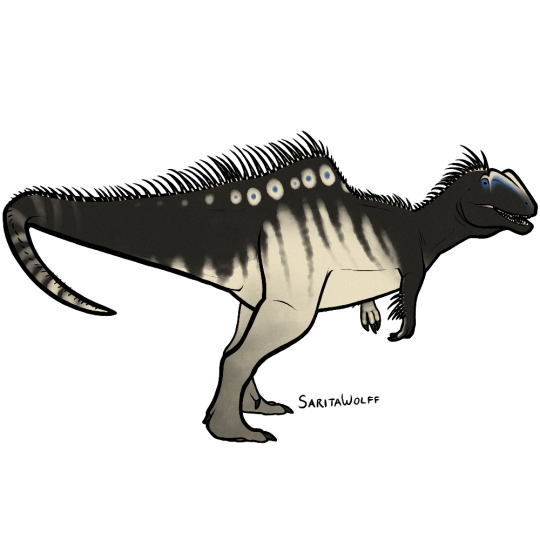
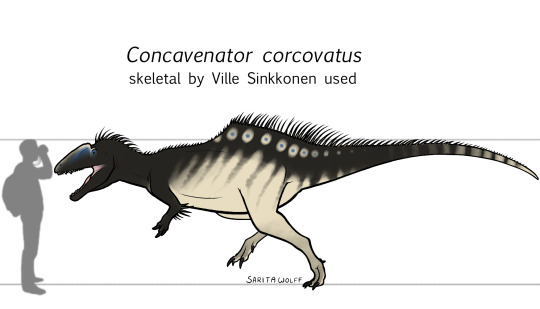
#Archovember Day 30 - Concavenator corcovatus
From the early Cretaceous of Spain comes the bizarrely crested carcharodontosaurid Concavenator corcovatus. Concavenator had two small, narrow “shark fins” on its back which possibly supported a hump. Like most sails and crests, the function of these structures is unknown. It could have been for thermal regulation or display, or both.
Concavenator has been the subject of much debate concerning its integument. Similar to Velociraptor, Concavenator had structures resembling quill knobs on its ulna. These could have been anchor points for quills similar to those seen in ornithischians like Tianyulong and Psittacosaurus, as complex wing feathers had not appeared in the fossil record yet, and especially not in allosauroids. However, if these quills are related to feathers, it would be evidence of true feathers appearing in dinosaurs other than the coelurosaurs. Complicating things are the impressions of scales found on various parts of Concavenator’s body, though none from its arms. There is some skepticism that these structures are not even quill knobs, but instead merely tendon attachments. As of now, there is not really a consensus on whether Concavenator was feathered, quilled, or fully scaled, and we can only hope for further evidence.
In the Las Hoyas site of the La Huérguina Formation, Concavenator would have lived alongside an array of crocodylomorphs, amphibians, and enantiornithine birds, the ornithomimosaur Pelecanimimus, the iguanodontian Mantellisaurus, the tapejarid pterosaur Europejara, and mammals such as Spinolestes.
11 notes
·
View notes
Link
by emeraldlove
Severus and Harry take Teddy to the Natural History Museum. 🦖🦖🦖
For the Harry100 community on Dreamwidth.
Challenge Prompt 462 - Museum
Words: 100, Chapters: 1/1, Language: English
Series: Part 27 of Harry Potter works 2023
Fandoms: Harry Potter - J. K. Rowling
Rating: General Audiences
Warnings: No Archive Warnings Apply
Categories: M/M
Characters: Harry Potter, Severus Snape, Teddy Lupin
Relationships: Harry Potter/Severus Snape
Additional Tags: Community: harry100, Drabble, Museums, Dinosaurs, Fluff, Tooth-Rotting Fluff
2 notes
·
View notes
Text
Carnotaurus . . Eustreptospondylus. … …
Acrocanthosaurus. Carcharodontosaurus. Um… uh.. . . . ssssss.. . Stegosaurus. Ummmmm….. Mantellisaurus.
Quetzalcoatlus. But not Hatzegopteryx.. I’m biased sorry… um um. Postosuchus. It’s Mesozoic it counts. Coelophysis.
Conifers? EYEAH. Ferns? Mhm.. Grass? Whos That? Never heard of her…. Edmontosaurusessssss. Ummmnm.. urrrrrr ummmm uhhhhh. Nrghfgh

okay I’m better. :]]
.. … . Parasaurolophus. Monolophosaurus. ‘loph’ is crest. Dilophosaurus. Saurolophus.
Holy shit.
Carnotaurus again.
4 notes
·
View notes
Text
Episode 483: Hadrosaur holotypes and duck-billed diets
I Know Dino Podcast Episode 483: Hadrosaur holotypes and duck-billed diets. A new small African hadrosaur, Minqaria, was named; Mantellisaurus was redescribed and found to be a valid genus; Maiasaura had a high metabolism; and much more
Episode 483: Hadrosaur holotypes and duck-billed diets. A new small African hadrosaur, Minqaria, was named; Mantellisaurus was redescribed and found to be a valid genus; Maiasaura had a high metabolism; and much more
News:
New lambeosaurine dinosaur from Morocco, Minqaria bata source
A new description of Mantellisaurus (including a complete 3D scan of the 80% complete holotype) confirms that…

View On WordPress
1 note
·
View note
Text
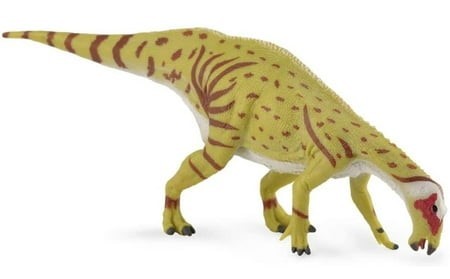



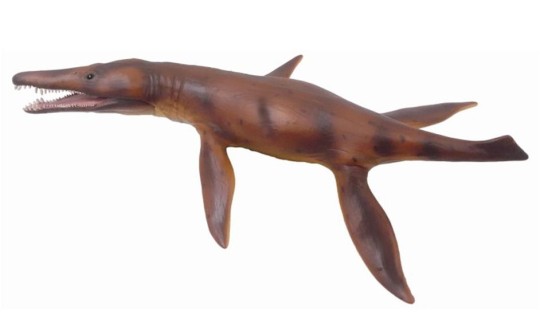
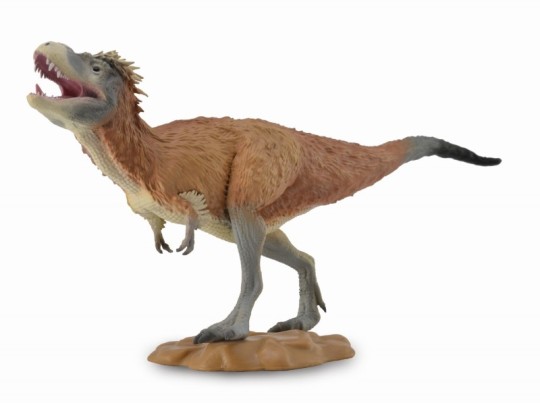


CollectA Prehistoric Series
(Mantellisaurus, Torosaurus, Deinocheirus, Daeodon, Kronosaurus, Trex, Elasmosaurus, Shastasaurus)
1 note
·
View note
Text

2023 Wrap-Up: March 6th - March 27th
Hmm. I should stop thinking that I'll be doing this as a weekly exercise and more of ---- whenever I have the time and energy and motivation to write a wrap-up. 😂
Today is Kaoru Sakurayashiki's birthday! So I am sorry if you follow me on Twitter. There has been a lot of likes and retweets of my favorite character from SK8 the Infinity over there. (Twitter is where the cool kids hang out from the fandom. 😂 The fandom is so much bigger and has so much to offer over there. Kinda wish there are more crossposters between there and Tumblr.)
I published two SK8 the Infinity reverse bang pieces, which I am always thrown for a loop. I am so use to anon posting and having the mods do it for me -- coming from Harry Potter -- so that when I participate in other fandom fests & big bangs I am always ???? in how posting works. Which is strange, since I didn't start out my fest writing adventures via Harry Potter. I just been embedded in the HP fandom for awhile now that I forget other decorum exists. 😂
I started out the month with a bang with reading. However, like my writing, somewhere in the middle of March I hit a slump. My trek on finishing the Fanfic Reading Challenge is hitting a snag, but!!!! I discovered a new Harry Potter pairing to sink my teeth into, so I might or might not to a round-up on my readings. (But if I don't then how am I suppose to keep myself accountable? 😂 )
Below the cut are some Kaoru Sakurayashiki art recs & the fanfics I published since I last updated.
Recs ~ ~
99channel_xxx - Link
mi_kadoya - Link
souo_o - Link
suponji_327 - Link
nukoyamap - Link
wunvarnn - Link
kiyuko4179 - Link
sk_ango - Link
yamasuke050 - Link
HAPPY BIRTHDAY, KAORU!!!!! 🌸🌸🌸
Fics ~ ~
Mooncalf or Mantellisaurus atherfieldensis? (Harry Potter, Snarry, Rated G) AO3 / Dreamwidth
Cherry Blossoms (SK8 the Infinity, Matchablossom, Rated G) AO3 / Dreamwidth
Weak Tea (Harry Potter, Snarry, Rated G) AO3 / Dreamwidth
Athens (SK8 the Infinity, Matchablossom, Rated G) AO3 / Dreamwidth
Not Having to Ask (SK8 the Infinity, Matchablossom, Rated G) AO3 / Dreamwidth
Leave the Light on for Me (SK8 the Infinity, Loveblossom, Rated E) AO3 / Dreamwidth
1 note
·
View note
Photo

Dinovember day 2. This time it’s Mantellisaurus!
37 notes
·
View notes
Photo
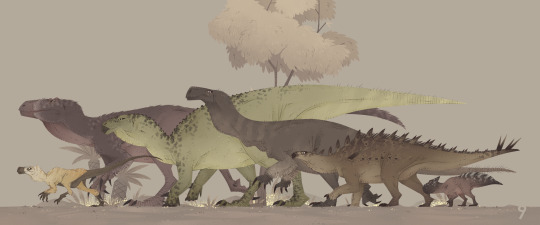
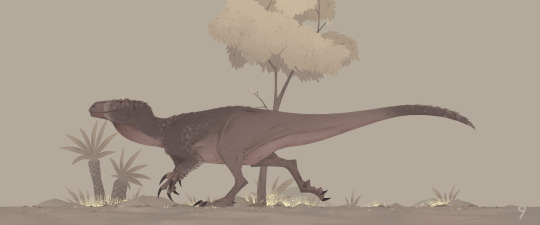
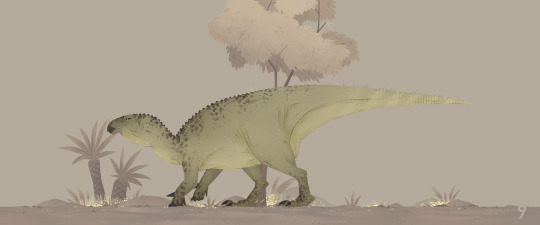
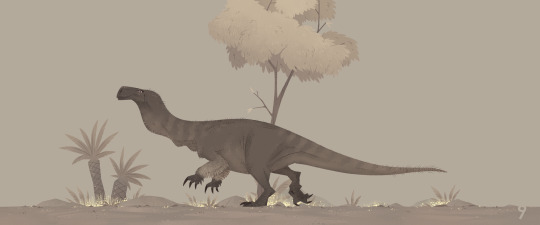
A random selection of dinosaurs I felt like drawing, Gnathovorax, Murusraptor, Mantellisaurus, Aardonyx, Huayangosaurus and Yamaceratops.
Also images of Murusraptor, Mantellisaurus and Aardonyx on their own.
#art#my art#digital art#paleoart#sciart#paleontology#dinosaur#theropod#ornithopod#sauropodomorpha#stegosaur#ceratopsian#gnathovorax#murusraptor#mantellisaurus#aardonyx#huayangosaurus#yamaceratops
876 notes
·
View notes
Text
Round Two: Berthasaura vs Ceratosuchops
Berthasaura leopoldinae

Artwork by @i-draws-dinosaurs, written by @i-draws-dinosaurs
Name meaning: Bertha and Leopoldina’s reptile (in honour of naturalist and women’s rights activist Bertha Maria Júlia Lutz, and first Empress of Brazil and advocate for Brazilian independence Maria Leopoldina)
Time: Uncertain, likely ~121 to 75 million years ago (Aptian to Albian stages of the Early Creataceous) but may be younger
Location: Goio-Erê Formation, Brazil
Theropods are famously carnivorous dinosaurs, but many, many groups of theropods have decided “actually but what if I didn’t” and gone vegetarian, and yet it’s still wild when another one of those pops up every now and then. Even among them though, Berthasaura is special for being the only theropod that seems to have tried to just straight up turn itself into an ornithopod. The long spindly legs, the teeny little arms, and a big head with a toothless beak all come together to create an utterly bizarre little theropod that honestly nobody could have predicted.
Berthasaura is a noasaur, and those of you familiar will at this moment be saying “oh of course it’s a noasaur” because those guys were small ceratosaurs that were basically Theropod Wacky Experimental Phase 1.0. Within this group you’ve got wild sticky-outy teeth, a single weight-bearing toe on each foot in our fellow competitor Vespersaurus, and now multiple instances of beaks evolving independently. Theropods just love to evolve a beak, what can I say? Whatever the hell Berthasaura had going on, it must have been successful because as the basalmost noasaurid currently known its direct lineage has been surviving since at least the Late Jurassic!
Ceratosuchops inferodios
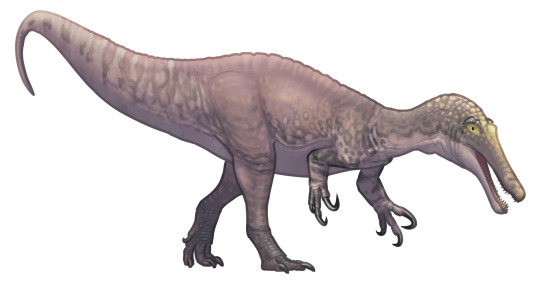
Artwork by @i-draws-dinosaurs, written by @zygodactylus
Name Meaning: Horned Crocodile Faced Hell Heron
Time: ~128 million years ago (Barremian stage of the Early Cretaceous)
Location: Wessex Formation, Isle of Wight, England
Say hello to the Hell Heron! Ceratosuchops is one of many new Spinosaurs described recently, showcasing the sheer diversity of this group as well as their much larger spread than previously believed. Ceratosuchops, previously thought to be just Baryonyx, is one of such new taxa that point to the entire group originating in Europe, a piece of their evolutionary puzzle not previously well known. Ceratosuchops was about 8.5 meters long, and had a long crocodile-like skull, with a horn on the top of it (hence its name). As a spinosaur, it would have probably been an aquatic stalker (you know, like a heron) - waiting near bodies of water for food, and snatching it up before it could swim away. Just, the difference between Ceratosuchops and actual herons, well, this was a big heron. It probably wouldn’t have had a sail, though it is possible it may have had a ridge like its close relative Suchomimus. It lived in a heavily river-filled environment, giving it a wide variety of locations to choose from for hunting. Besides a vast diversity of invertebrates, sharks, ray-finned fish, salamanders, lizards, turtles, many kinds of Neosuchians, Plesiosaurs, mammals, and pterosaurs, Ceratosuchops lived alongside other dinosaurs such as Hypsilophodon, Brighstoneus, Iguanodon, Mantellisaurus, Valdosaurus, Polacanthus, Eucamerotus, Oplosaurus, Ornithopsis, Aristosuchus, Calamosaurus, Calamospondylus, Eotyrannus, Neovenator, Ornithodesmus, Yaverlandia, Vectiraptor, Thecocoelurus, and even another spinosaur, Riparovenator!
#dmm#dinosaur march madness#dinosaurs#birds#dmm rising stars#dmm round two#palaeoblr#birblr#paleontology#bracket#march madness#polls#berthasaura#ceratosuchops
177 notes
·
View notes
Photo
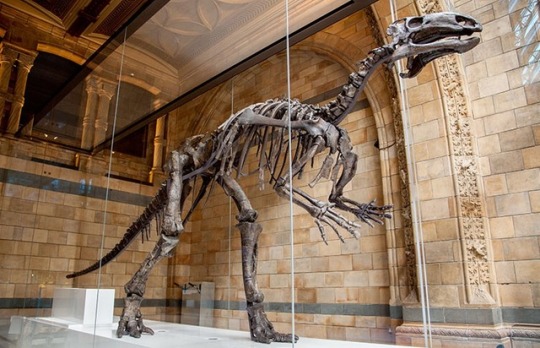

Mantellisaurus is another poor Iguanodontian who was previously lumped into the Iguanodon species, like so many others. Misidentified for more than eighty years, Mantellisaurus was reassigned from Iguanodon atherfieldensis to Mantellisaurus atherfieldensis in 2007-2008. It is smaller than Iguanodon bernissartensis, with front legs that are shorter, about half the length of the hind legs.
http://www.nhm.ac.uk/discover/search-for-the-real-iguanodon.html
34 notes
·
View notes